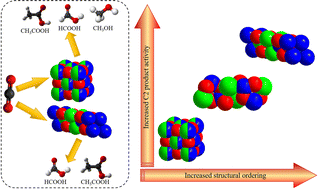Structural ordering enhances highly selective production of acetic acid from CO2 at ultra-low potential†
Abstract
Electrochemical reduction of CO2 to value-added chemicals and fuels using renewable energy technologies is known to facilitate the creation of an artificial carbon cycle. Although the practical use of most conventional electrocatalysts is curbed by the low efficiency and poor stability of the catalyst there is also the need of large input energy in the form of potential. In this work, a family of bismuth-based transition metal chalcogenides was designed to enable multi-electron transfer for selectively reducing CO2 to acetic acid at ultra-low potential of −0.1 V (vs. RHE). The structural design in AgBiS2, CuBiS2 and AgBiSe2 facilitated an optimized CO adsorption accounting for the production of acetic acid at low potential. The disordered arrangement of Ag and Bi in AgBiS2 also favors CO hydrogenation, which leads to the formation of a large amount of methanol in addition to acetic acid. However, an induced structural ordering of these atoms upon selected substitution enhanced the lattice strain in CuBiS2 and AgBiSe2 favoring only C–C coupling and 100% acetic acid is produced at lower potential with stability up to 100 hours. The origin of the CO2 reduced product has been validated by 13CO2 isotopic experiments and the mechanistic pathway has been proposed with the support of in situ IR experiments. Finally, a 4 times improvement in the current density of the best catalyst, AgBiSe2, was achieved in a flow cell configuration, which produced the highest ever acetic acid yield at lower potential with a faradaic efficiency of 49.81%. This work provides a novel strategy to improve electrochemical performance towards the formation of high value-added chemicals selectively at ultra-low potential.

- This article is part of the themed collection: Carbon Dioxide utilisation


 Please wait while we load your content...
Please wait while we load your content...